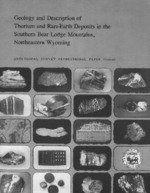The Bear Lodge Mountains are a small northerly trending range approximately 16 km northwest of the Black Hills in the northeast corner of Wyoming. Thorium and rare-earth deposits occur over an area of 16 km 2 in the southern part of these mountains. These deposits occur in the core of the Bear Lodge dome in a large multiple intrusive body made up principally of trachyte and phonolite. Two types of deposits are recognized: disseminated deposits and veins.
The disseminated deposits are made up of altered igneous rocks cut by numerous crisscrossing veinlets. The disseminated deposits contain thorium and rare-earth minerals in a matrix consisting principally of potassium feldspar, quartz, and iron and manganese oxides. Total rare-earth content of these deposits is about 27 times that of the thorium content.
The general size and shape of the disseminated deposits were outlined by making a radiometric map using a scintillation counter of the entire Bear Lodge core, an area of approximately 30 km 2 . The most favorable part of this area, which was outlined by the 40 countJs (count-per-second) isograd on the radiometric map, was sampled in detail. A total of 341 samples were taken over an area of 10.6 km 2 and analyzed for as many as 60 elements. Rare earths and thorium are the principal commodities of interest in these deposits. Total rare-earth content of these samples ranged from 47 to 27,145 ppm (parts per million), and the thorium content from 9.3 to 990 ppm. The amount of total rare earths of individual samples shows little correlation with that of thorium. Contour maps were constructed using the analytical data for total rare earths, thorium, uranium, and potassium. The total rare-earth and thorium maps can be used to define the size of the deposits based on what cut-off grade may be needed during mining. The size is large as the 2,000 ppm total rare-earth isograd encloses several areas that total 3.22 km 2 in size, and the 200 ppm thorium isograd encloses several areas that total 1.69 km 2 . These deposits could be mined by open pit. The Bear Lodge disseminated deposits have one of the largest resources of both total rare earths and thorium in the United States, and although the grade of both commodities is lower than some other deposits, their large size and relative cheapness of mining make them an important future resource.
Vein deposits in the Bear Lodge Mountains include all tabular bodies at least 5 cm thick. Twenty-six veins were noted in this area. These veins are thin and short; the longest vein was traced for only 137 m. Minerals vary greatly in the amount present. Gangue minerals are commonly potassium feldspar, quartz, or cristobalite intermixed with varying amounts of limonite, hematite, and various manganese oxides. Rare earths and thorium occur in the minerals monazite, brockite, and bastnaesite. Thorium content of 35 samples ranged from 0.01 to 1.2 percent, and the total rare-earth content of 21 samples from 0.23 to 9.8 percent. Indicated reserves were calculated to a depth of one-third the exposed length of the vein. Inferred reserves lie in a block surrounding indicated reserves. Indicated reserves of all veins are only 50 t of Th0 2 and 1,360 t of total rare-earth oxides; inferred reserves are 250 t of Th0 2 and 6,810 t of total rare-earth oxides.
The Bear Lodge dome, which underlies the greater part of this area, is formed by multiple intrusive bodies of Tertiary age that dome up the surrounding sedimentary rocks. In the southern part of the core, the younger intrusive bodies surround and partly replace a granite of Precambrian age. This granite is approximately 2.6 b.y. old. The sedimentary rocks around the core are (from oldest to youngest): Deadwood Formation of Late Cambrian and Early Ordovician age, Whitewood Limestone of Late Ordovician age, Pahasapa Limestone of Early Mississippian age, Minnelusa Sandstone of Pennsylvanian and Early Permian age, Opeche Formation of Permian age, Minnek


